
26 minute read
Your wild spring
26 22
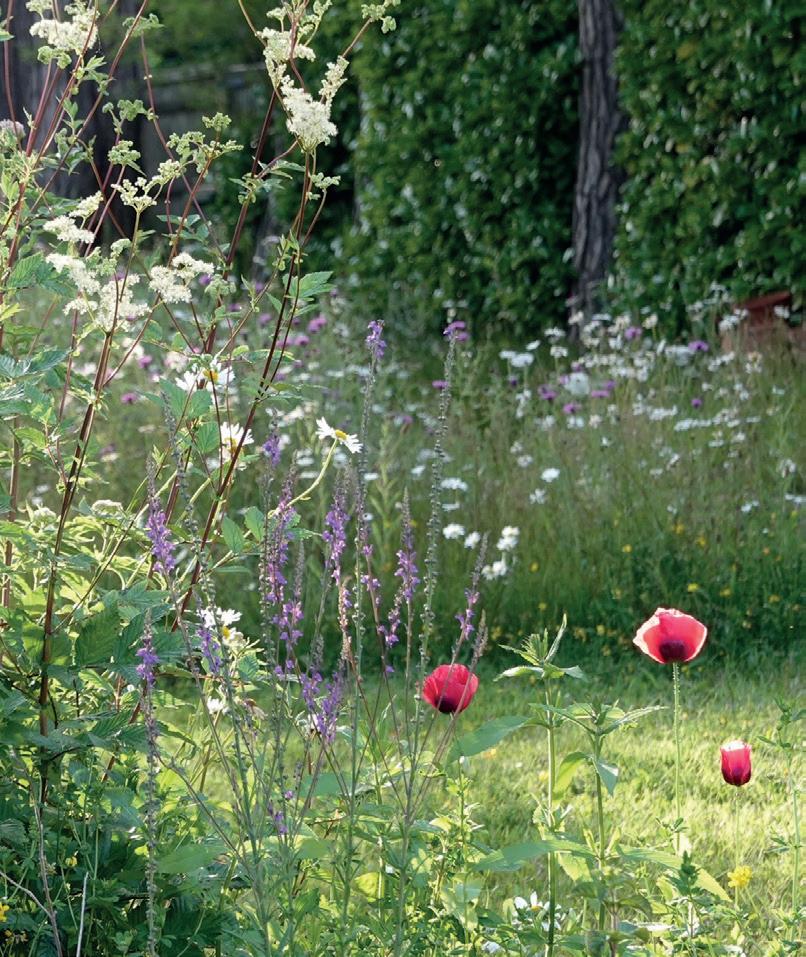

JANE P
MIKE READ
Contents
4Your wild spring
Seasonal wildlife and places to experience it.
8Pamber Forest in leaf
Discover the wonders of woodlands in spring, focusing on Pamber Forest, an ancient forest just outside Basingstoke.
10 Wild news
15 Focus on: Waste of Space
Our new campaign to transform disused places into wildlife havens.
16 Gardening
How you can plant for wildlife and grow fruit and veg at the same time.
18 Seabirds
All about the fascinating world of seabirds, from life in a colony to where they go when they leave our shores.
22 Team wilder
Inspiring stories from local people who are taking action for wildlife in their communities.
24 Best places to see blue butterflies
Our two counties are home to some of the most spectacular displays of blue butterflies in the UK, find out where to look for them.
26 A Wilder Wight
Plans are coming together to create a truly wilder Island. Read about species reintroductions, rewilding and new nature reserves in the county.
30 My wild life
Graham and Marion, volunteers with Wilder Portsmouth, tell us about the work they have been involved with to make their city wilder.
6 ways to get involved with your local Wildlife Trust
Volunteer Could you donate your skills and time to look after wildlife? Visit our website to find opportunities near you (please check for restrictions due to Covid-19).
Donate to an appeal
From purchasing land to protecting species, exciting projects near you need your support. Campaigning You can play a vital role in raising awareness and lobbying on local and national issues.
Local groups Join one of our network of local groups and help make a difference to nature where you live. Events Join us for an online event or activity near you. Our events are organised by knowledgeable and enthusiastic staff and local groups..
Leave a legacy If you’ve had a lifetime’s pleasure from nature, help ensure its future by leaving us a gift in your Will.
Thank you Thanks to your support, we have been able to conserve and maintain habitats for brown hares and other threatened farmland wildlife. www.hiwwt.org.uk


Thank you Thanks to your support, we are able to create and maintain habitats for dormice and many other vulnerable species. www.hiwwt.org.uk Your wild spring The best of the season’s wildlife and where to enjoy it.



Brown hare sits alert in a eld – often their long ears are the only clue they are present.
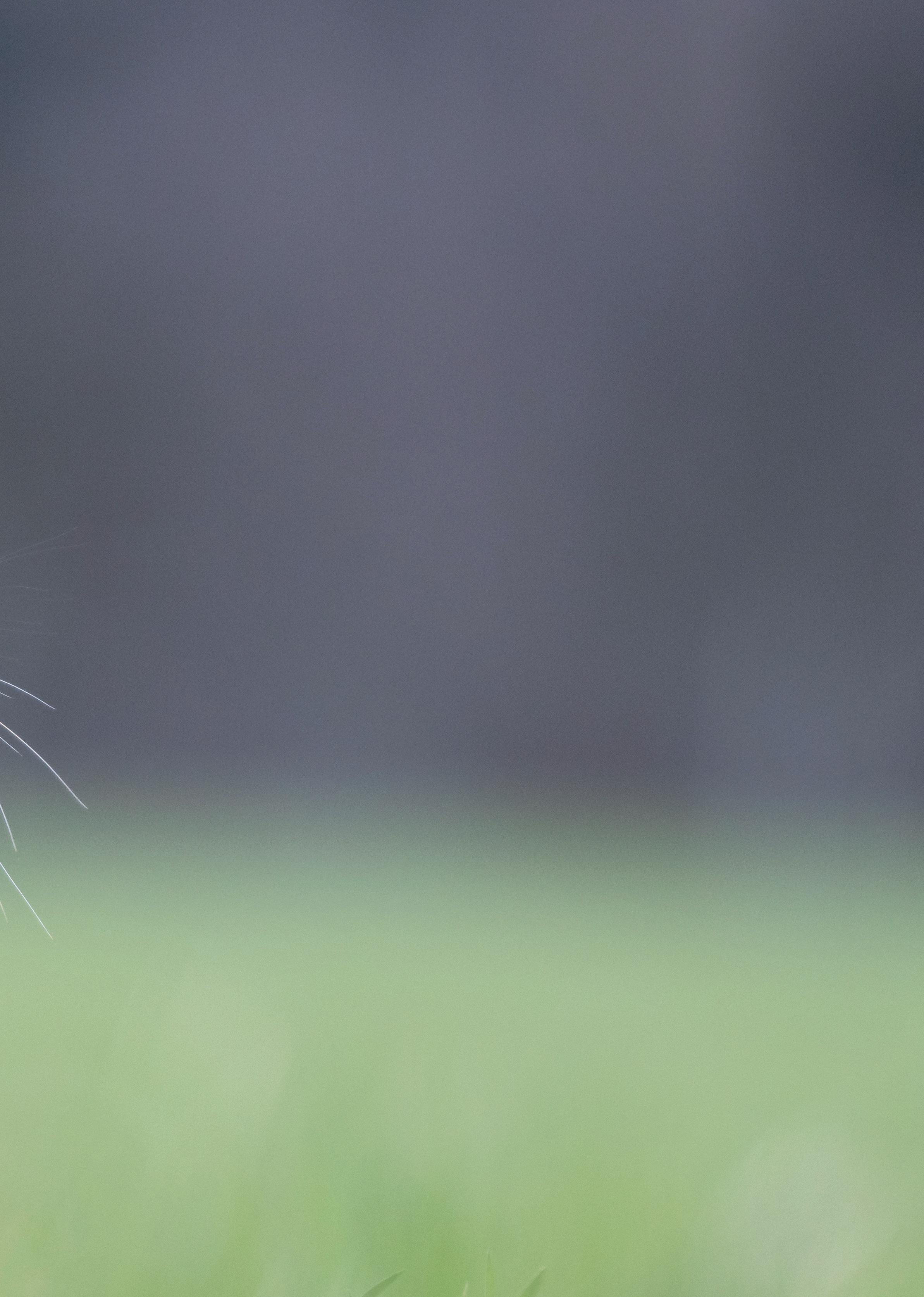

SPRING SPECTACLE
In the ring
Brown hares are particularly active in spring and more visible in the countryside. Unlike rabbits, hares do not dig burrows but make shallow hollows, known as a form, which they tuck themselves into when they are not feeding. They can be seen nibbling on shoots in grassland, farmland and woodland edges. If you get too close they might give you a bit of a shock by bursting from their forms and running away in zigzags at full tilt.
In spring you might even be lucky enough to spot ‘mad March hares’ boxing, standing up on their hind legs to do so. It was once thought these boxing matches were between males, but now we know it is a fed-up female ghting o male advances.
We work with farmers to help them ensure their land is wildlife friendly. For brown hares this means leaving long grass for cover and margins where they can feed.
SEE THEM THIS SPRING
Barton Meadows Nature Reserve Our downland reserves around Winchester are creating a connected landscape for hares. Look out for them on the woody margins near arable land.
JOSHUA COPPING
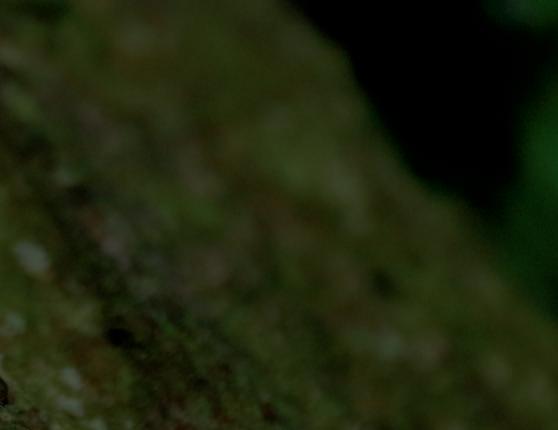



Long-eared bat
URBAN FIELDCRAFT
Crabs
If you have ever gone down to the seashore and gently turned over rocks, you will almost certainly have come across at least one of the 62+ species of crab found around the British coast. Female crabs will be carrying eggs from January onwards; whilst they do they are known as ‘berried’ females. Depending on the species, the female might carry these eggs for many months, before she releases them into the water to hatch. The tiny crabs, miniatures of their parents, are very fragile, and tasty prey for many creatures. They tend to hide away until they are a bit larger, and some species take years before they will breed themselves.

LOOKING FOR CRABS
Make sure to replace any rocks and animals just Shore crab as you found them. Rock pools provide shelter and habitat for hundreds of species.
On the wing
All sorts of animals are starting to reappear as the weather warms, including those that have spent much of the winter asleep. Bats will be venturing out on warmer evenings, hoping to nd plenty of insects to feed on. If temperatures drop again in early spring, don’t be surprised if bats in your area are suddenly absent again. They will have gone back into torpor, similar to hibernation, to wait out the cold. By mid-April most bats should be fully awake and looking to feed up to regain some of the weight they lost in winter. Bats might be seen away from their hibernation roosts as they start to venture further a eld at night, with females gathering in maternity roosts later in the spring.
Shore crab
WHICH CRAB?
Three of the most common species of crab are edible (look for a pie crust edge), velvet swimming (red eyes and a mean grip) and shore crabs (very variable but o en green in colour with a broad shell). Try to learn these fi rst, before you get to grips with less common species.
SEE THIS
See if you can nd a swathe of blue in a woodland near you as bluebells come into ower – a sign that the trees may be ancient ones.
NEIL ALDRIDGE
DO THIS
Look for newts in your pond as they return to the water for the breeding season after a winter under rocks or in log piles.
SPECIES SPOTLIGHT Spring nectar hunters
Ashy mining bee (andrena cineraria)
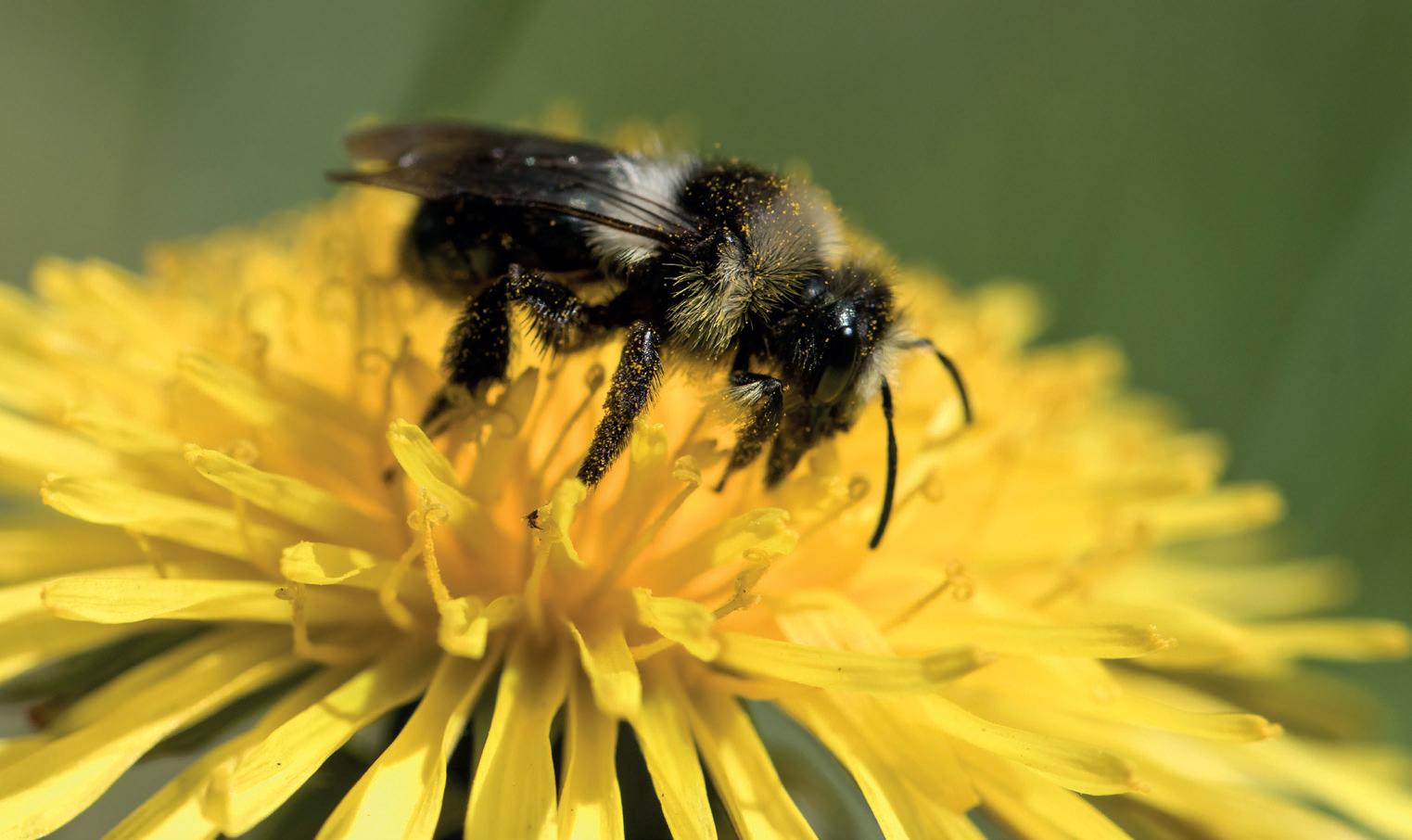
3 species to spot
Hairy-footed fl ower bee
These solitary bees are some of the rst to emerge in spring and their super long tongues mean they can feed on a variety of owers. Try to spot them at Martins Wood, part of Newchurch Moors Nature Reserve.

When someone says ‘bees’, does your mind go automatically to the honey
bee? There are hundreds of types of bee in Britain, in fact around 270 diff erent species. These range from large furry bumblebees to tiny insects that might look more like fl ies to most of us.
The majority of bees you see out in the countryside or your garden will
be species of solitary bee, some much easier to identify than others. These bees do not always live up to their name as they do sometimes live in small colonies, o en in the ground. They have developed some weird and wonderful ways to build their nests: combing wool from furry leaves, cu ing exact shapes from leaves and refurbishing old snail shells are just a few. As solitary bees make up a high proportion of British pollinators they help ensure healthy populations of wildfl owers and food crops in our countryside.
Ge ing to know some of the bee species
in your garden can be a delight, and you will see the diff erent species as you go through spring and into summer. Depending on their tongue length, the bees may be able to take nectar from long tubular fl owers, or only feed on fl owers with easily accessible, open heads. Some spring bees are well-adapted to certain habitats while others are generalists and can be found almost anywhere there is food for them.
One solitary bee species that is
unmistakeable is the ashy mining bee. The females’ broad grey stripes are very distinctive and you can easily spot the results of their nesting habits in grassy areas, including lawns. As they burrow into the earth, they leave behind li le mounds of soil. You can spot the entrance hole if the bees are out foraging, but as soon as they fi nish for the day, or if it rains, they will seal themselves in to their underground chamber. Look for these earth mounds and the bees feeding on fl owers at Arreton Down Nature Reserve on the Island.
To fi nd out how you can help bees, and other insects, please visit our website www.hiwwt.org.uk/action-for-insects Early bumblebee
These bumblebees have orange and yellow stripes and are on the wing from March to October. They favour woodland and gardens, see if you can nd one amongst the oral displays at Ancells Farm Nature Reserve.
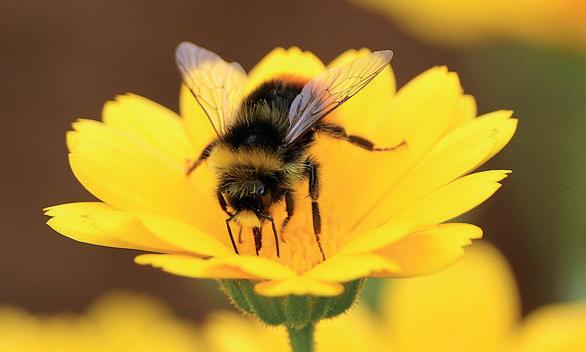
Red mason bee
These bees build nests from mud in any holes they nd. They happily live in bee hotels, so keep an eye out for them if you install one in your garden. Early owering plants will ensure they have something to feed on as they emerge from late March.

Pamber Forest looking green in the springtime.

Pamber Forest in leaf

Wildlife was declining in this ancient woodland until the 1980s, but new management for conservation has breathed life back into the forest.
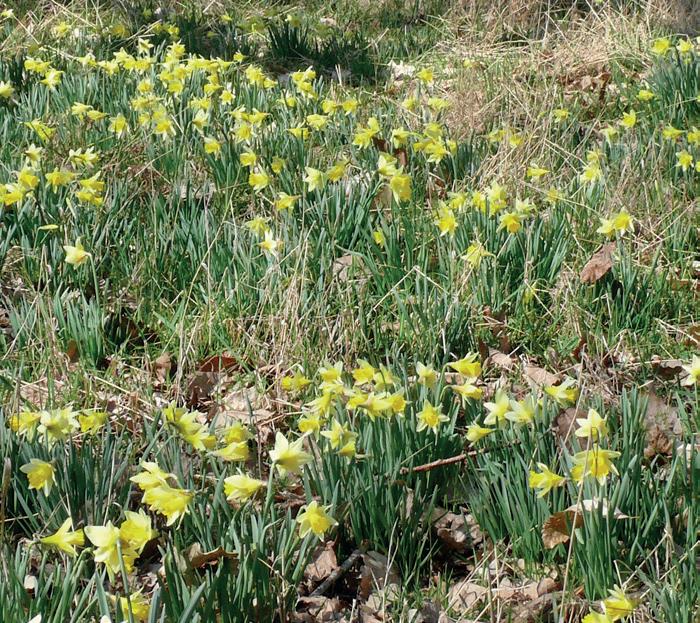
Coppicing

Pamber Forest Nature Reserve is a broadleaf woodland, not far from busy Basingstoke. Some of the oldest trees in the woodland are oaks of over 300 years old. You might spot these veteran trees from one of the many trails and footpaths that wind their way through the forest. The forest itself has stood for more than 800 years, meaning it is home to unique plants and trees that only grow in ancient forests.
Spring is the perfect time to visit the woodland to see some of these species for yourself, although it is full of wildlife in any season. One person who knows this be er than most is Graham Dennis, reserves offi cer for Pamber for the past 30 years.
Restoring traditional management
The nature reserve was once an extensive royal forest, still sizeable now at almost 500 acres. Traditionally some of the trees, mainly hazel, were coppiced. This technique involves cu ing trees down to the ground in diff erent areas of the wood in rotation, with the timber used for many products including building materials, tools and charcoal. The practice of coppicing declined as the need for its products waned, consequently changing the structure of the woodland.
Regularly cu ing sections of the wood allows trees to regrow with multiple trunks, forming dense cover with more space between trees. This allows more light into the forest. Increased light allows a beautiful array of wildfl owers to grow in spring, many of them indicators of ancient woodland. Look out for wild daff odils, the white stars of greater stitchwort and
Da odils
Wood anemone after coppicing
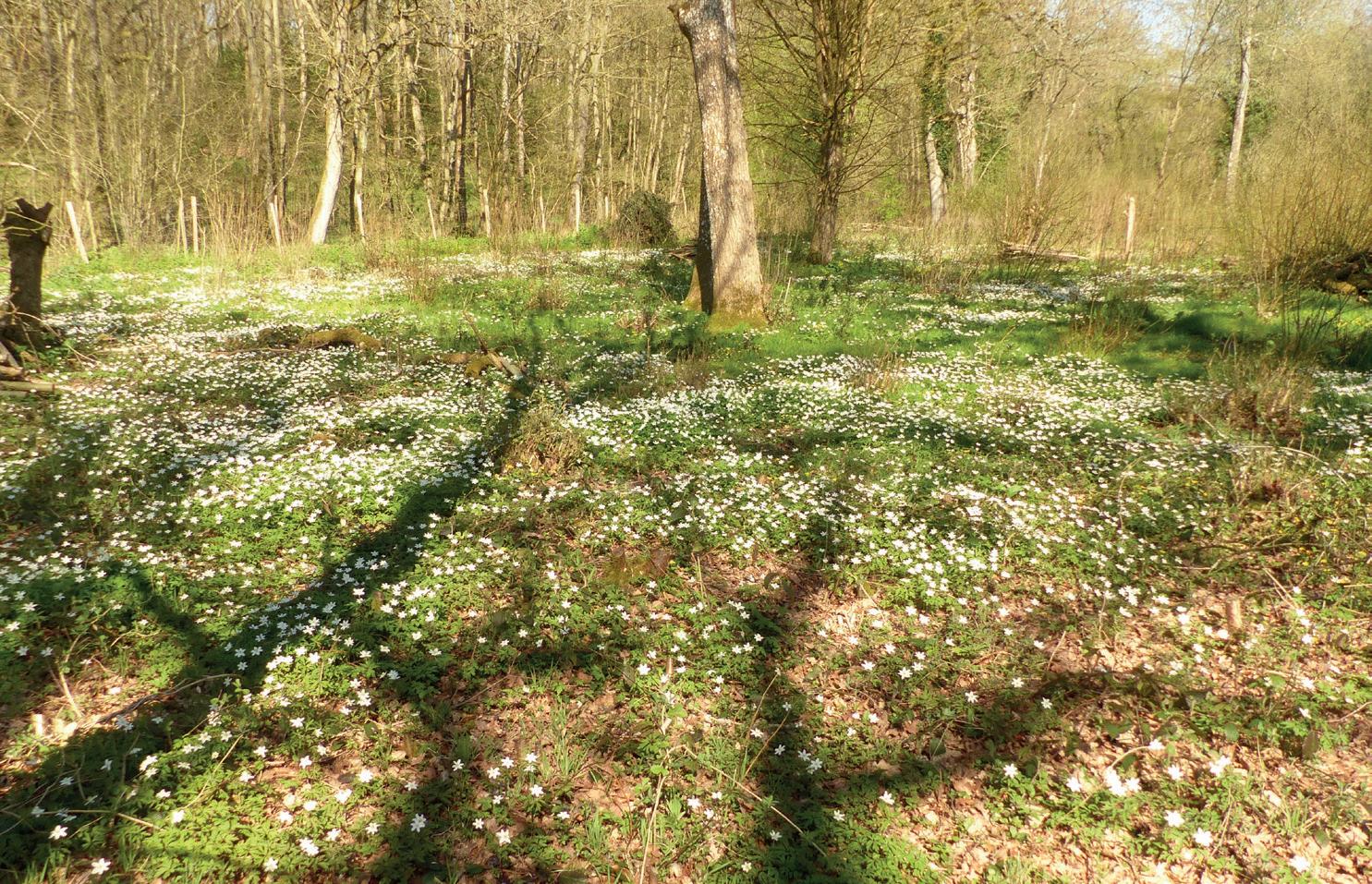
violets in the springtime. These fl owers provide food for invertebrates and Pamber Forest is one of our most prolifi c sites for bu erfl ies and moths. Over 800 species, including rarities such as the purple emperor, silver-washed fritillary and drab looper moth, have been recorded.

The reserve is owned by Englefi eld Estate, leased by Basingstoke and Deane Council and managed by the Trust on their behalf. When the Trust fi rst took the site on in the 1980s, we had our work cut out! The fi rst job was to reinstate coppicing and restore the rides (open grassy tracks through the woodland). Very quickly species, which had been lost in Pamber, began to reappear, having clung on in small fragments of habitat. A changing climate has also led to other new arrivals such as the eyecatching blue underwing and Jersey tiger moths. While for now the warmer climate is bringing new arrivals, widespread warming will mean many more are lost from the reserve despite our conservation eff orts.
Keeping track of Pamber’s wildlife
Spring is the start of survey season for the ecologists on the reserve. As the reserve is home to such a diversity of invertebrates, surveying these species is particularly important. The results and trends make sure the management we carry out is helping the wildlife as it should. Bu erfl y monitoring in the forest can record over 5,000 bu erfl ies in a good year but it is quite variable, the weather having a large impact. Another species that will be monitored in Pamber is the hazel dormouse, starting to wake up for spring and return to the treetops a er a winter asleep on the forest fl oor.
Graham’s work in Pamber Forest since the 1990s gives him the benefi t of seeing the results of his conservation eff orts. In 1991, seeing a buzzard was a rarity, with sightings perhaps fi ve times a year. Now, though, he will o en see fi ve a day! Other species doing well on the reserve are red kites, badgers, woodcock and the dark crimson underwing moth – recently recorded as breeding on the reserve.

Drab looper moth Blue underwing moth Silver-washed fritillary
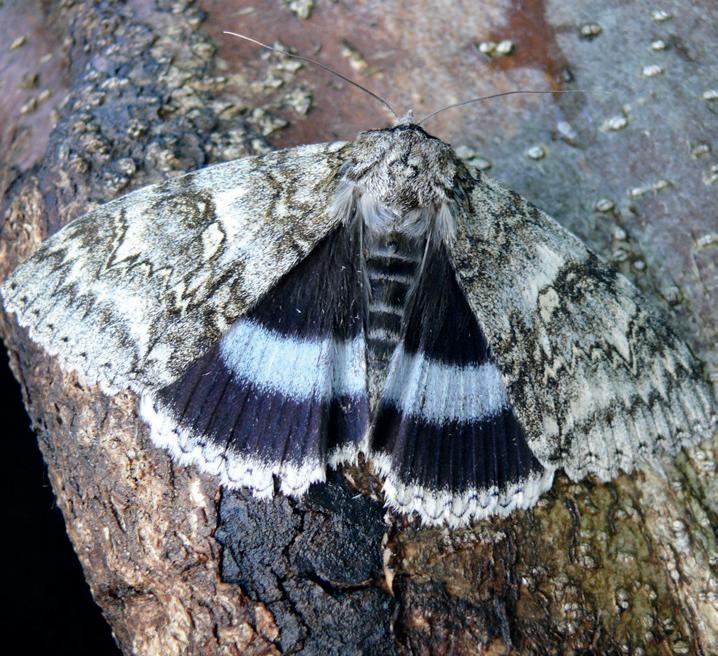
Walking in the forest
Last spring was the busiest ever for Pamber, with many people discovering the woodland for the fi rst time. As the reserve is so large the increased footfall doesn’t seem to have had a negative eff ect on the rich wildlife of the forest. Coppiced areas are fenced, so the most fragile areas were already protected from potential disturbance.
The Pamber Forest trail is a two-mile loop that takes you past many of the points of interest in the wood and is a great way to get to know the reserve. Make sure to pay it a visit this spring - witnessing the forest bursting with life in this season is not to be missed.
Hampshire and the Isle of Wight have lots of fantastic woodland to visit. Here are two more to see this spring.
FLEXFORD NATURE RESERVE
A gem of ancient woodland and wet meadow in Chandlers Ford. A stream divides the reserve and in spring you get the best of both habitats. The meadows will be bright with colour from wild owers including the marsh marigold and early butter ies like the orange tip will be appearing. The woodland oor will be a carpet of blue as the bluebells ower and ransoms (wild garlic) make it a spring treat for all the senses.
ROYDON WOOD NATURE RESERVE
A very special woodland, home to numerous species, particularly birds. Nightjar, tawny owl and skylark are just a few of the species that breed here in the mosaic of habitats. Spring is the time to see bluebells and the trees transition with the season, with leaves at their brightest green. Roydon Woods are grazed by cattle and ponies to help keep areas open for wild owers and butter ies.
WILD NEWS
13,000
signatures
Thank you to everyone that signed our petition asking the council to reconsider this development, adding weight to our campaign.
Tipner West – threatening Portsmouth’s wildlife

It’s like a broken record. A special place for wildlife is under threat from a council-approved building project: locals protest the loss of green space, wildlife experts describe the impact on nature, the developers take concerns ‘very seriously’ and yet the layers of concrete still come. These developments show we are not yet in a society that grows within our environmental limits and gives the climate and ecological crises the priority they deserve.
A 67-acre site at Tipner West in Portsmouth has been proposed as the site of over 4,000 houses and a massive land reclamation scheme. This would decimate the harbour’s last remaining green oasis; an intertidal mudfl at home to rare and important species like brent geese, black-tailed godwit and dunlin. This area is also a haven for juvenile bass and is a habitat that helps fi ght climate change by capturing and storing carbon dioxide.
Tipner is a perfect example of nature’s value being given a lower priority than economic growth. This is a place with the highest level of protection for wildlife as a Site of Special Scientifi c Interest (SSSI), a Special Protection Area (SPA), and a ‘Ramsar’ globally important protected wetland. It should be safe from harm. If the development goes ahead here, it will set a damaging precedent that any protected nature site in the country can fall foul of inappropriate building projects.
This time is diff erent because we are ahead of the game. We are gathering public opposition before the 2021 consultation even starts! So far, over 13,000 people have signed our petition calling for Portsmouth City Council to scrap this damaging project and instead, preserve the site for nature’s recovery and local wellbeing. People everywhere are standing up for nature and a wilder future. Join us in telling the Council #dontgothere, so we can change the record not only in Portsmouth but throughout Hampshire and the Isle of Wight, and the country. Keep up to date with the campaign and sign our petition
www.wtru.st/scrap-super-peninsula
Online AGM proves a great success
With so many things a li le diff erent last year our AGM was no exception. The Trustees decided in the summer that the safest way to hold the meeting would be online, so on Tuesday 10 November the 2020 AGM was held via Zoom webinar.
We were unsure how many members would register to a end, so we were delighted when over 300 joined us online; a record number for an AGM. Everything ran smoothly; we used Zoom’s polling to conduct the voting on the formal business and the Q&A function enabled members to put questions to the panel.
Our President, Chairman, Treasurer, CEO and Senior Management Team were of course disappointed not to be able to welcome members in person and chat
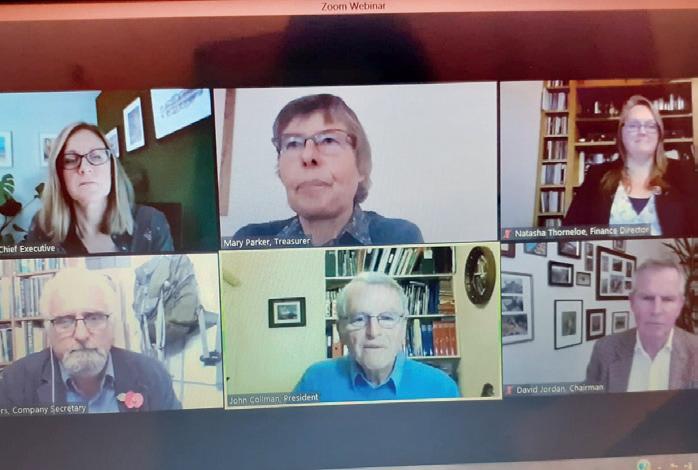
New video created showing the recent impact of gifts in Wills
The Trust has been fortunate enough to receive gifts in Wills from a number of people over recent years. These kind individuals lived both locally and further afield, but all had a special connection to our wildlife and landscapes, and chose to make a gift to protect them into the future by supporting our work.
The gifts have ranged in value from a few hundred pounds to over £300,000 but each will make its own impact and enable more work to be carried out, more land to be protected and managed and more wildlife to thrive. We are truly grateful for every legacy gift.
We recently made a short video highlighting the impact of two generous gifts which allowed us to purchase and create Newchurch Moors Nature Reserve on the Isle of Wight and Deacon Hill Nature Reserve near Winchester, home to the Duke of Burgundy butterfly. You can take a look at the video, which gives more detail on these sites and our plans for the future at www.hiwwt.org.uk/
wilder-gifts

to them over a cup of tea as in previous years. Thankfully the record-breaking attendance and positive feedback received helped to make up for it, and we were delighted to be joined by so many new members who had never been to an AGM.
If you were unable to attend the AGM you can view recorded highlights of the meeting at www.hiwwt.org.uk/agm .
Last year’s experience has shown it is possible to hold an AGM online and with so many members welcoming the change it is now an option for future meetings. The Trustees are considering plans for the 2021 AGM, and our aim is to make sure as many members as possible are able to be part of the meeting.
Together
we’re stronger
Here are some ways that our work has helped wildlife thrive and engaged people with nature across our two counties.
103,031
4,060
The number of views on our educational videos since the first lockdown last March.
110
Species of plant found on the latest botanical survey of Mapledurwell Fen, the Trust’s smallest reserve.
Thank you!
8Hectares of wildlife-friendly farmland habitats managed across the UK by the Jordan’s Farm Partnership, which has three farms in our counties.
631
The record number of species of butterfly and moth recorded in Pamber Forest Nature Reserve in 2020, read more about how we manage the reserve for wildlife on page 8.
WILD NEWS
Natural History GCSE welcomed by the Trust

2023 could see the introduction of a new GCSE, the rst since computer science was introduced in 2014. At Hampshire & Isle of Wight Wildlife Trust we welcome the idea of a GCSE in natural history. In fact, we think it’s fantastic that young people with an interest in the subject will be able to deepen their learning, and their connection to nature, through dedicated study. However, the GCSE is only a step in the right direction. We believe children should have the opportunity to have immersive learning experiences in nature throughout their whole school lives. This could be done in a combination of three ways:
Learning in nature can be as straightforward as choosing to read a story outside or encouraging pupils to take their self-directed study to a quiet spot outside, instead of sitting in the library.
Learning with nature, perhaps, using leaves to understand fractions or playing Pooh sticks in a river to understand velocity.
Learning through nature is so much more than knowing the names of trees, plants and animals. This is about full immersive experiences, which o er children and young people the opportunity to build con dence, resilience and, crucially, o er much-needed bene ts to mental and physical health.

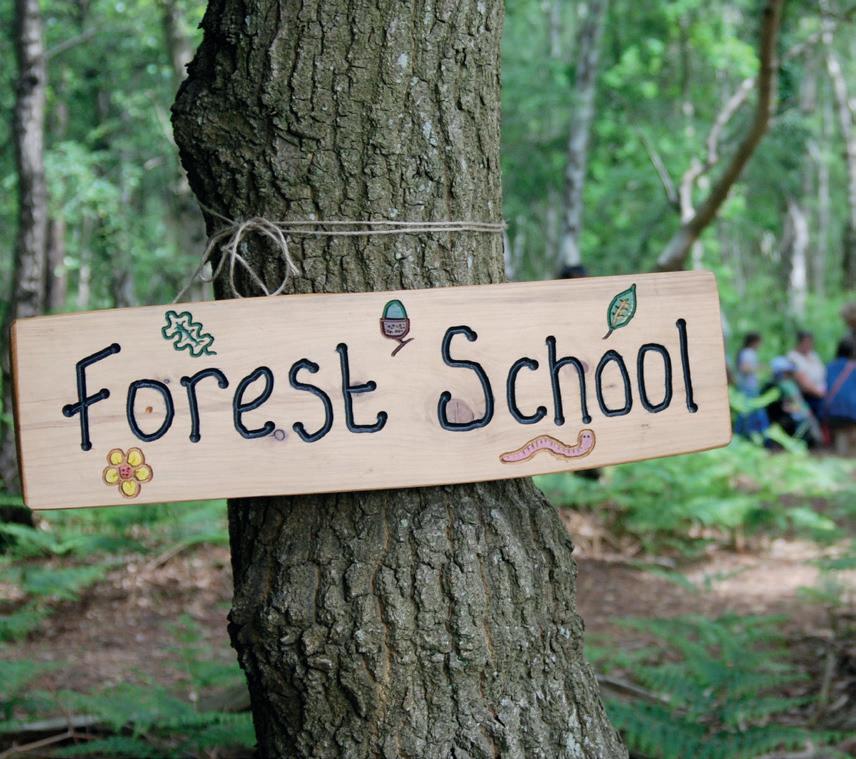
NATALIE LIGHT Volunteer Brian Matthews pulling Himalayan balsam along the Avon Water during Summer 2016.
New Forest NonNative Plants Project
The New Forest Non-Native Plants Project has continued to make excellent progress despite the challenges of Covid-19. This partnership project, hosted by the Trust, aims to stop the spread of invasive nonnative plants in the New Forest area. Since then, Project Offi cers Catherine Cha ers and Jo Gore, with the help of volunteers and professional contractors, have tackled over 20 non-native species which spread rapidly and have a detrimental impact on our native vegetation.
The control of Himalayan balsam has been particularly satisfying. This nonnative plant has invaded riverbanks in the New Forest but has short roots and is relatively easy to pull up, making it an ideal activity for volunteers. The Project Offi cers continued to lead balsam pulls during 2020, in accordance with social-distancing requirements, and were delighted to fi nd relatively few balsam plants at many sites where balsam pulling has been undertaken previously.
Since the Project started in 2009, enthusiastic volunteers have given more than 20,600 hours on balsam pulls led by Jo and Catherine. The Project Offi cers are grateful to all those who have generously given so much time, o en working in hot, wet or very muddy conditions.
To fi nd out more about The New Forest Non-Native Plants Project please contact
Catherine.Cha ers@hiwwt.org.uk
Watercress and Winterbournes off to a f lying start
Since ge ing fully underway in autumn 2020, the Watercress and Winterbournes Landscape Partnership Scheme, supported by the National Lo ery Heritage Fund, has gone from strength to strength. Despite the Covid-19 restrictions, the 16 scheme partners have made fantastic progress in enhancing and celebrating seven local chalk streams. We restored the Pillhill Brook at Li le Ann, adding natural bank defences, planting trees, and creating valuable fi sh-spawning habitat. At Hurstbourne Priors we repaired sluices, notched a weir and built a rock ramp, opening a large stretch of the Bourne Rivulet to species like brown trout and grayling. The historic Eel House in Alresford was fortifi ed by crucial repairs, thanks in part to a donation from the scheme. Our support also helped primary school children in Cheriton to improve their stream - they planted wildfl owers along the banks, boosting wildlife habitat and tackling erosion. We continued upskilling our brilliant volunteers, giving them online training in water vole ecology and invertebrate identifi cation. New research provided insight on natural solutions to fl ooding, and our photography competition is capturing the streams in all their vibrancy. Community members are also ge ing inspired to design and run their own projects through our new grant scheme.
WATERCRESS & WINTERBOURNES

ANDREW GOLDSWORTHY
INVESTING IN WILDLIFE
Corporate members are welcomed by Trust
We are delighted to welcome Isle of Wight based company, XV stripes as our newest Corporate Member. Inspired by a love of coastal living and the ocean, XV Stripes captures the essence of laid back luxe for your bedroom and home. Plus, all of their fabrics and bres are sustainably sourced. The team have been busy working on a design, inspired by the Solent, which will support the work of the Trust. We look forward to sharing it with you soon. xvstripes.com

Also joining our wonderful family of corporate supporters is Wightlink – see page 29 for more information. If your company shares our vision for a wilder future and would like to get involved and invest in wildlife please contact Michelle at corporates@ hiwwt.org.uk or visit www.hiwwt.org.
uk/corporate-support
The results are in!
Thanks to everyone who returned our Members Survey that came with the winter magazine; we’ve had a great response and wanted to give you a few highlights. Over 90% of responses advised that the reason they became a member was to support local wildlife, and over 50% feel a sense of loyalty to the Trust. Over lockdown we saw an increase in the number of subscribers to the Enews, and over 70% of responses said they read the Enews. You told us that Facebook is your most popular social media platform, and over lockdown you followed us on social media for wildlife information and tips to help wildlife from home. Many of you advised that you would like to swap to a digital copy of the magazine, which is something we are looking into now (watch this space!).
Finally, the picture you considered the most eff ective way of promoting the work of the Trust to new audiences was beautiful St Catherine’s Hill!

WILD NEWS
More marine secrets to discover in 2021
2021 will see Secrets of the Solent returning for a busy and exciting year lled with lots of opportunities for people to learn about and help to protect our amazing local marine habitats and wildlife. You could visit our marine litter sculpture and exhibition at Portsmouth Museum, where you can also see other exhibits about the fascinating history of the Solent. Keep an eye out for our Solent lm this spring, starring some wonderful Solent wildlife and our inspiring Marine Champions. If you would like to get hands-on, then why not join us for an Intertidal survey to record valuable data about the species living in our area, or go a step further and talk to us about becoming a Marine Champion volunteer to help engage and inspire others.
Visit our project webpage to sign up to our newsletter for information on taking part and our project activities.
www.hiwwt.org.uk/secrets-of-the-solent
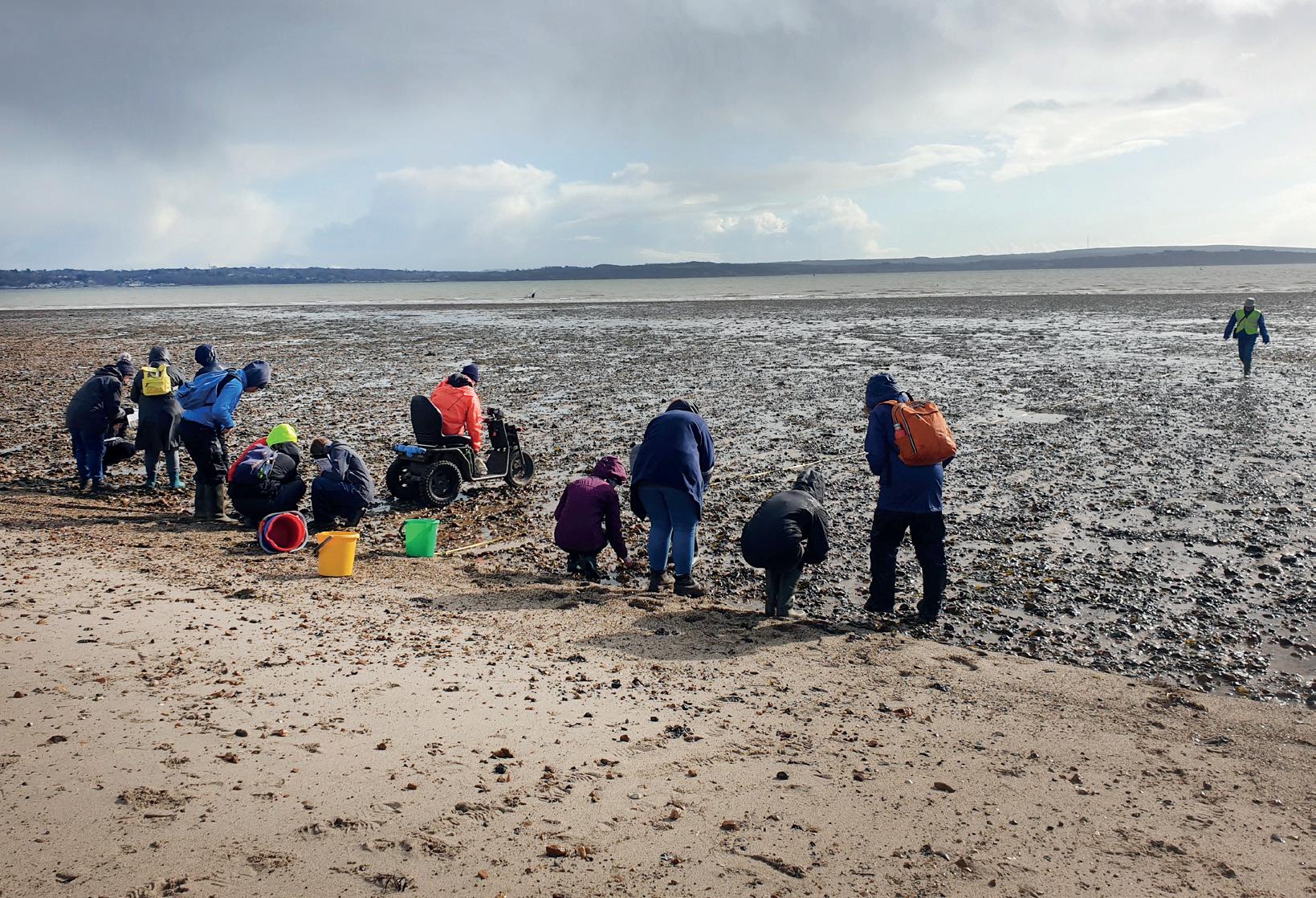
Trusts across England, Scotland and Wales have received £2 million in funding from People’s Postcode Lo ery. For the fi rst time, all 44 Wildlife Trusts in Britain will benefi t from player support. We would like to thank all players for helping raise these vital funds which will help Trusts harness the power of nature to fi ght climate change!
The money will be used to fund nature restoration projects which will help lock up carbon in our peatlands, meadows, wetlands and at sea.
Wild habitats have a huge role to play in addressing climate change when healthy. They can reduce the risk of fl ooding, help prevent coastal erosion, improve people’s health and wellbeing, as well as maintain healthy soils, clean water and the pollinators needed by farmers for their crops.
News in brief
New president for the movement
Liz Bonnin, broadcaster and biologist, was elected in November as the president of the Wildlife Trusts. Liz will be championing The Wildlife Trusts’ new 30 by 30 vision to protect 30% of land and sea for nature by 2030 with projects ranging from land acquisition to peatland restoration and species reintroduction.
Liz is known for her powerful and ground-breaking documentaries including, Drowning in Plastic, Galapagos, Wild Alaska and Blue Planet Live. Liz’s career has taken her around the world, studying animal behaviours and shining a spotlight on important environmental issues.

30 Days Wild
Our popular summer campaign 30 Days Wild will be back again in 2021! Thousands of you took part in Hampshire and the Isle of Wight in 2020 and we want to make sure 2021 is even bigger. If you took part last year, we hope you are still feeling the bene ts and it has inspired you to get outside throughout the rest of the year– a little bit of nature makes us all happier and healthier. The millions of acts of wildness you completed in June help protect our wildlife and make our green spaces better. Join us for more this year – you can register your interest now at www.wildlifetrusts.






